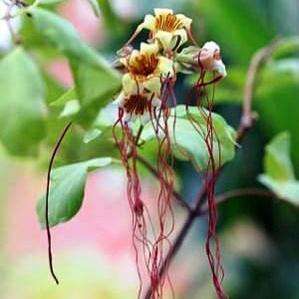
Strophanthus kombe - 3 Seed Pack - Indigenous South African Arrow Poison Vine - Worldwide Shipping
Check my rate
| Main centres: | 1-3 business days |
| Regional areas: | 3-4 business days |
| Remote areas: | 3-5 business days |

| Main centres: | 1-3 business days |
| Regional areas: | 3-4 business days |
| Remote areas: | 3-5 business days |

Strophanthus kombe Seeds
Kombe Arrow Poison

Strophanthus is a genus of 35-40 species of flowering plants in the family Apocynaceae, native mainly to tropical Africa, extending to South Africa, with a few species in Asia, from southern India to the Philippines and southern China. The name (strophos anthos, "twisted cord flower") derives from the long twisted threadlike segments of the corolla, which in one species (S. preussii) attain a length of 30-35 cm. The genus includes vines, shrubs and small trees. The leaves are opposite or whorled, simple broad lanceolate, 2-20 cm long, with an entire margin. Several of the African tribes used Strophanthus as the principal ingredient in arrow poison. Plants from this genus produce toxic alkaloids and cardiac glycosides g-strophanthin (syn. ouabain), k-strophanthin and e-strophanthin. As ordinarily administered, the drug acts on the heart before influencing any other organ or tissue. Often indeed no other action can be observed. It is used to produce the drug Ouabain which was taken as a cardiac stimulant to treat heart failure, and is similar to the drug Digoxin produced from Digitalis purpurea. Strophanthus kombe, the kombe arrow poison, is a vine that grows in the tropical regions of Eastern Africa, and is part of the genus Strophanthus, which contains approximately 38 species. S. kombe contains a cardiac glycoside which directly affects the heart. Historically, both the seeds and roots of the plant were used in the preparation of poison arrowheads used for hunting. Today, the seeds are used pharmaceutically for patients with certain heart conditions that affect blood circulation. The seeds are traded primarily with Europe, but have also been exported to the United States and Japan. Strophanthus kombe is known for its historical use as a source of arrow poison. Today it is used medicinally to treat heart failure. The plant has been used for two extremes, ending a life and saving a life, so proper dosage is crucial when using this plant medicinally. Cardiac glycosides extracted from the seeds reduce the heart rate but increase the force and efficiency of the contractions. Some glycosides can also be found in the roots and flowers. A mixture of glycosides known as strophanthin-k is found in the seeds. The purified compound is a white crystalline powder that is water-soluble and liable to hydrolysis under warm acidic conditions.
